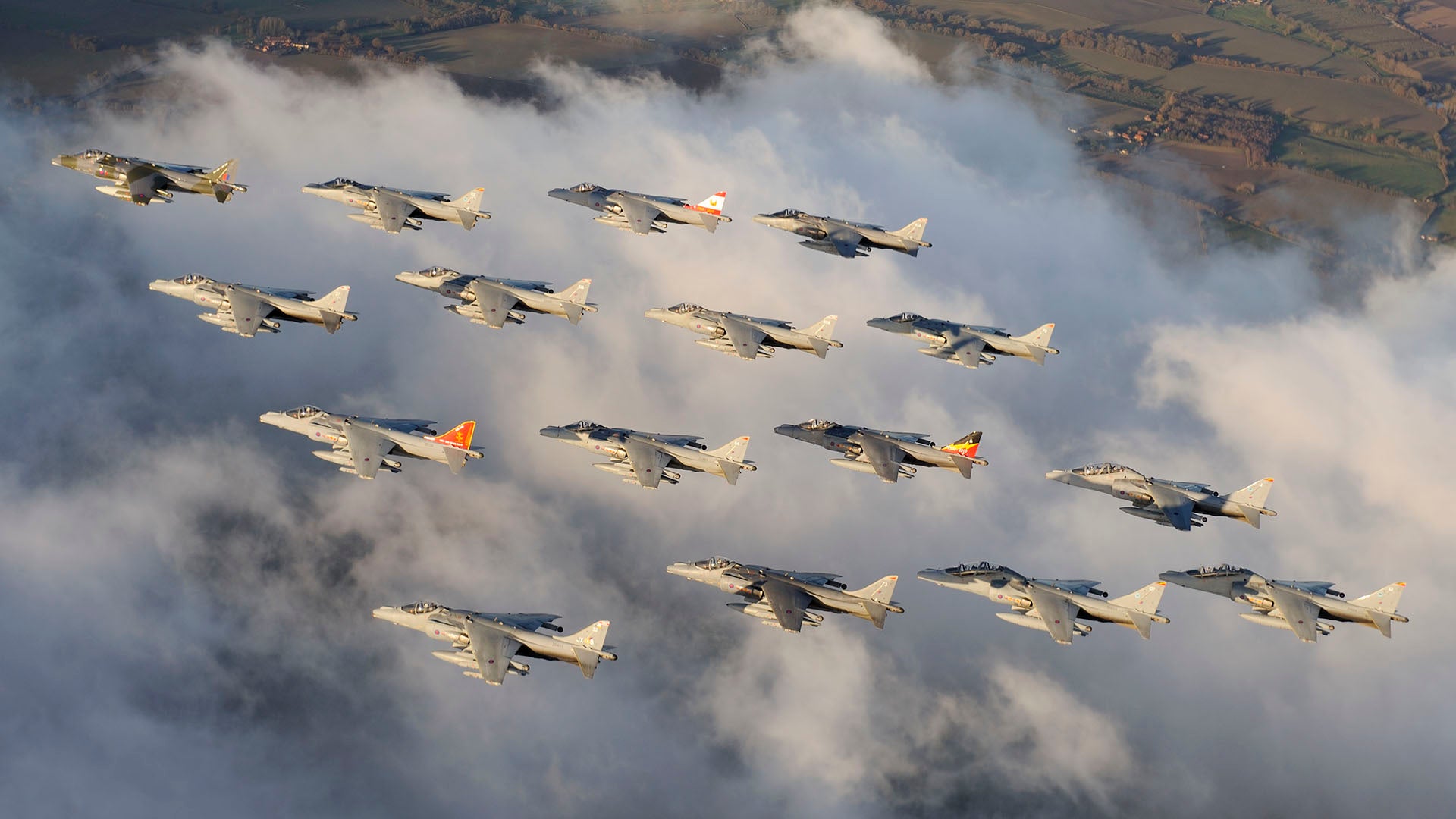Retired Air-Vice Marshal Gary Waterfall was one of the Royal Air Force’s most senior and experienced Harrier pilots when he was selected to become the figurehead of the United Kingdom’s Joint Force Harrier from September 2009. It was the start of a historic and deeply emotional rollercoaster journey that ultimately culminated in him having to personally oversee a highly controversial decision to completely shut down British Harrier operations over a short, two month period.
“I took charge of Joint Force Harrier as it came out of five years dedicated to operations in Afghanistan, with the view of getting it reconstituted, regenerated, and ready for small focused interventions from land or sea,” Waterfall told the War Zone.
However, even before he assumed his new role, the lingering economic crisis of 2007-2008 was leading politicians to look at potential cost savings across the entire defense landscape. By mid-2010, the Harrier force was smack-bang in the firing-line, but removing a British-born icon that occupied a place close to the hearts of the services and public alike would not be an easy task.
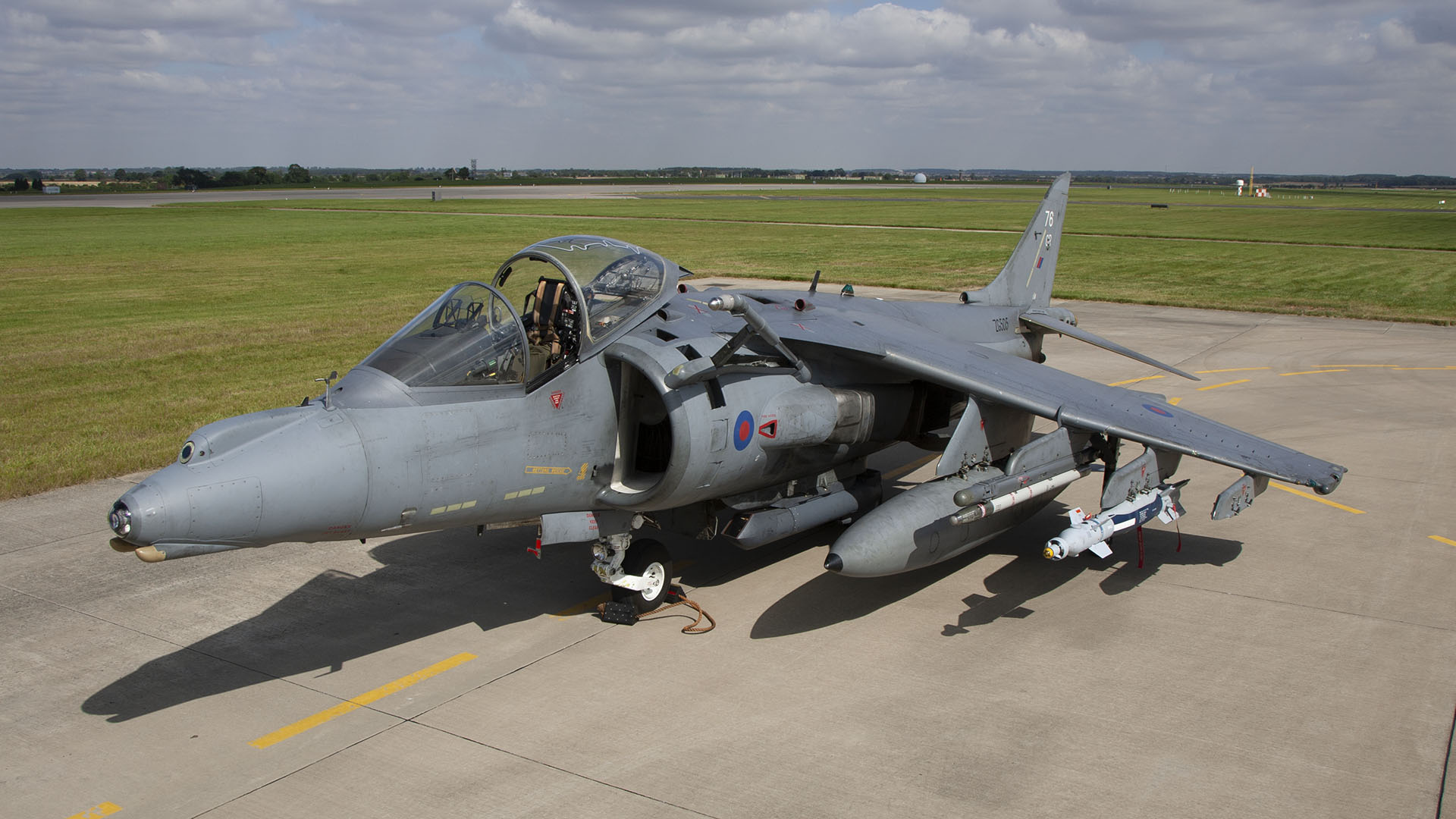
Saving money in hard times
In 2010, the United Kingdom’s new Conservative-Liberal Democrat coalition government faced a “black hole” in the defense budget that it inherited from the previous Labour Party administration. It had to find cash to fund a wealth of expensive new headline projects such as two new Queen Elizabeth class aircraft carriers — that were already underway and virtually impossible to cancel — and other immediate savings had to be made.
The Ministry of Defence’s Strategic Defence and Security Review (SDSR) is now firmly established as a five-yearly appraisal of the entire British defense landscape. It forms the basis of a frequent reassessment of capabilities against a constantly changing strategic environment. The first such review in 2010 was entitled “Securing Britain in an age of uncertainty” and it was also the first major review under the new government.
The SDSR of 2010 was broadly aimed at saving money in the immediate term, while also setting a new course for the decade ahead. The government faced what the review described as “an unfunded liability of around £38 billion over the next 10 years. That is more than the entire defence budget for one year. We must start to tackle this legacy before we can begin to put defence on a sound and sustainable footing for the future.”
Service chiefs vied to save as many prized assets as they could, but ultimately there was widespread resignation that there would be some serious casualties in the plans. Indeed, when the SDSR was released on Oct. 19, 2010, it contained one of the most severe rounds of cutbacks ever seen by the British military in modern times.
The wording of the tumultuous SDSR laid this out in stark terms. From an air power perspective, it said the government would “retain a reduced Tornado fleet, but remove the Harrier from service in 2011 as the fast jet force moves to two operational types — Joint Strike Fighter and Typhoon. Retaining the Tornado fleet allowed a fast jet contribution to be sustained in Afghanistan and support to concurrent operations which would not have been possible if Harrier was retained instead.”
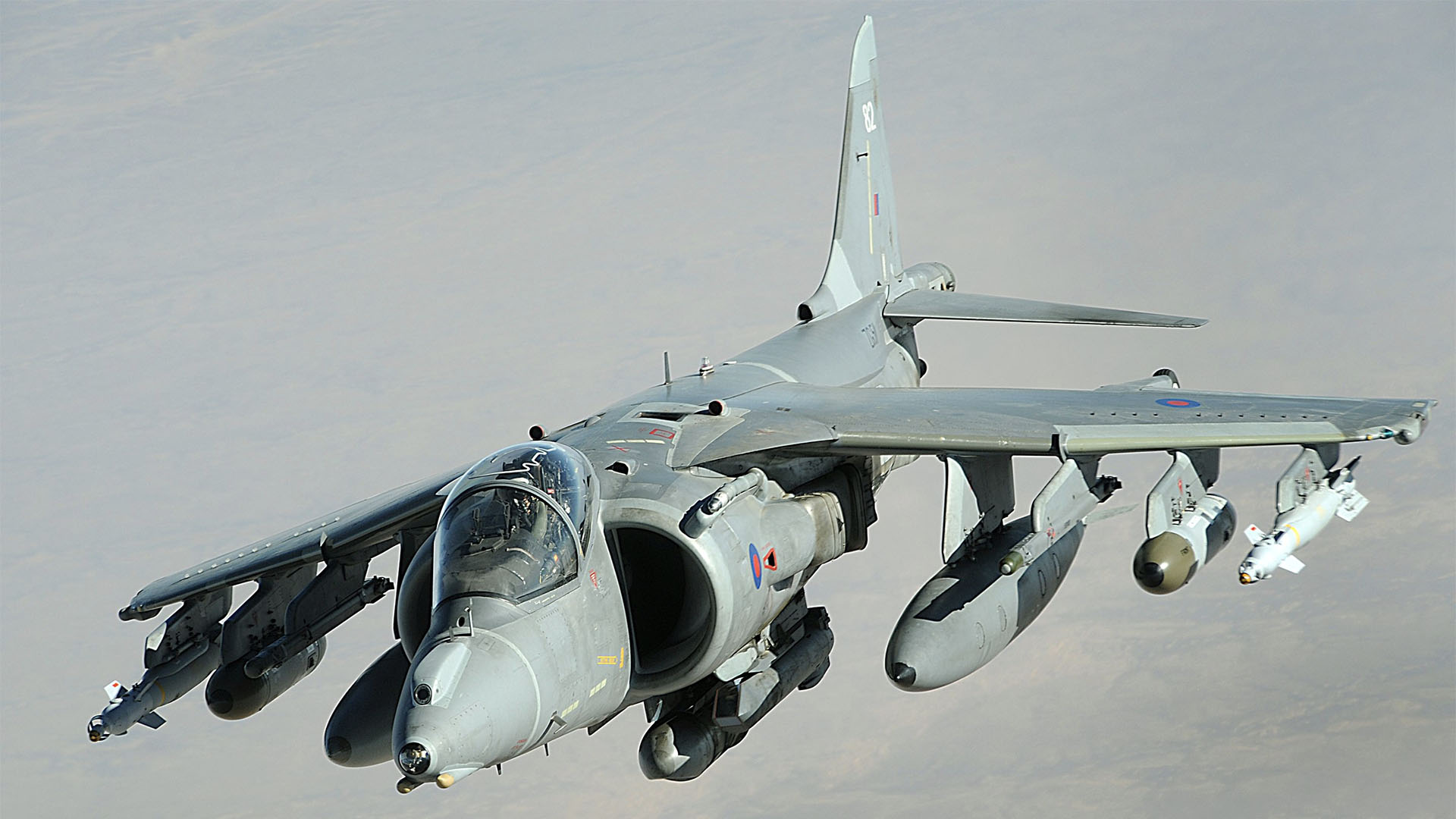
A British icon
The decision to close down the British Harrier force almost overnight was significant in many ways. The joint Royal Air Force/Royal Navy fleet of vertical/short take-off and landing (V/STOL) aircraft stemmed from a Cold War desire to operate from small, unprepared airstrips. It meant the aircraft could forward-deploy away from main air bases to locations less vulnerable to a potential Warsaw Pact attack.
The first Harriers, also known as GR1s, entered RAF service with No.1 (Fighter) Squadron at RAF Wittering on April 1, 1969. It included very advanced equipment for its day. It was the first RAF aircraft ever to boast a head-up display (HUD), an inertial navigation system (INS), and it had a moving map display.
For the Royal Navy, the Harrier became particularly significant. The ability to embark a force of capable fixed-wing multi-role combat aircraft aboard a small “Harrier carrier” was priceless. Traditional “cat-and-trap” Fleet Air Arm fixed-wing carrier operations had been sacrificed in the late 1970s. However, they were replaced by a new series of smaller carriers and a navalized Harrier was the only real option for the Royal Navy to retain a fixed-wing carrier strike capability.
The Fleet Air Arm’s Sea Harrier FRS1s were developed and fielded just in time for Operation Corporate in 1982. It was to herald a historic chapter in the Harrier’s life, when Argentine forces invaded the Falkland Islands in an effort to reclaim the British territory in the South Atlantic, some 300 miles off the Argentine coast and 8,000 miles from Britain.
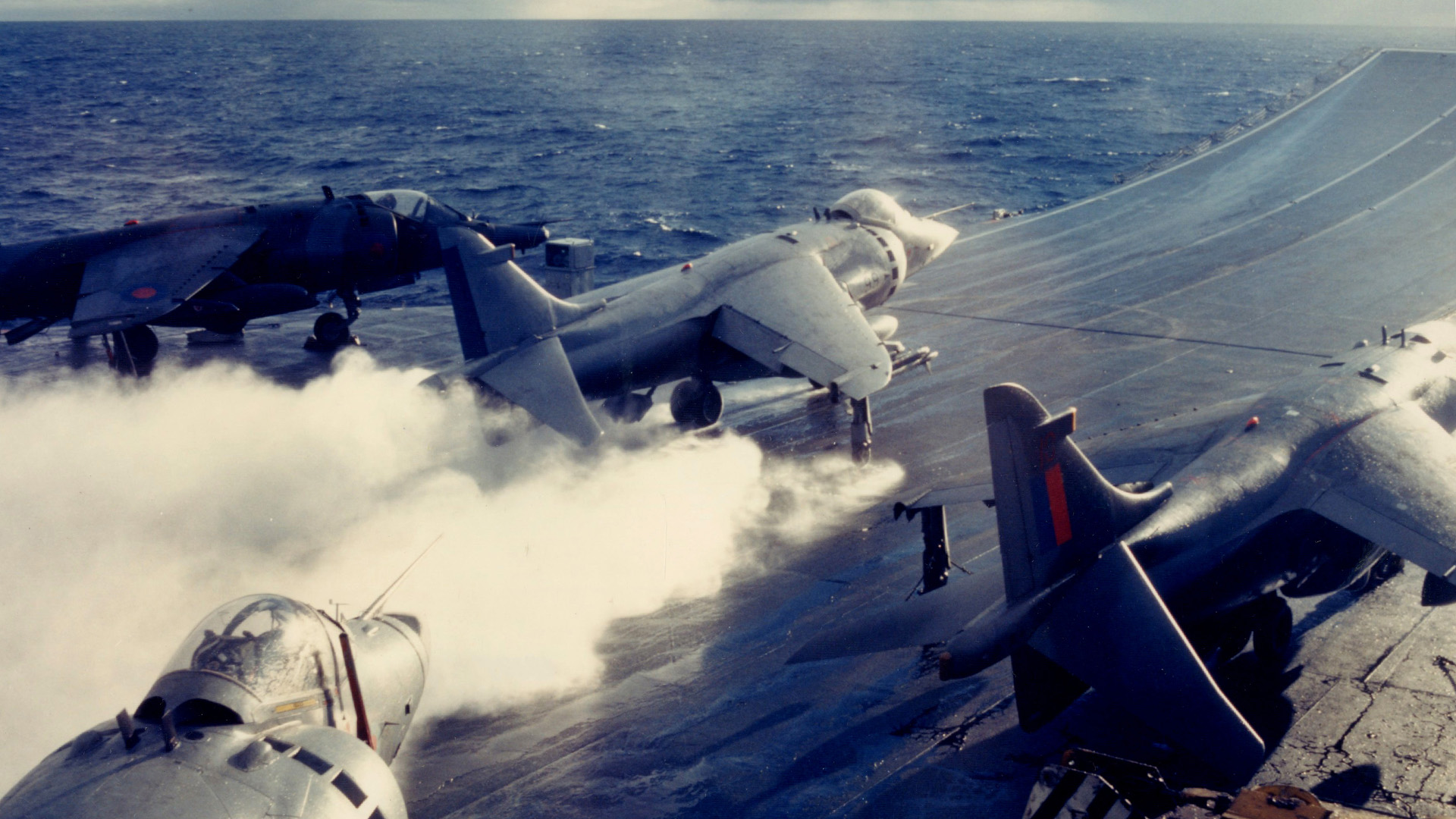
It fell to the ‘Harrier carriers’ to spearhead the response. Both HMS Hermes and Invincible were dispatched to the South Atlantic as part of a huge naval task force, with the Sea Harrier squadrons embarked as its centerpiece. The Sea Harriers of 800 and 801 Naval Air Squadrons (NAS) were boosted by the addition of RAF Harrier GR3s. What followed, and what this small force of vertical and short takeoff and landing (V/STOL) aircraft achieved, has rightfully passed into aviation legend.
The Royal Navy deployed some 28 Sea Harriers, which flew over 1,100 combat air patrols, and 90 offensive sorties. They claimed 23 Argentine aircraft “kills,” and played a pivotal role in the British victory.
The Sea Harriers were retired completely by 2006, all too soon after they had received an evolutionary upgrade to the FA2 standard. This included pairing the potent Blue Vixen multi-mode radar with the AIM-120 Advanced Medium-Range Air-to-Air Missile (AMRAAM), which provided the “Shar,” as the Sea Harriers were nicknamed, with impressive beyond visual range (BVR) capabilities.
Fast-forward to 2010 and the Sea Harriers had gone. The new RAF/RN Joint Force Harrier (JFH) operated the Harrier GR9. This was a very different beast to the earlier variants and had been developed in conjunction with McDonnell Douglas in the United States.
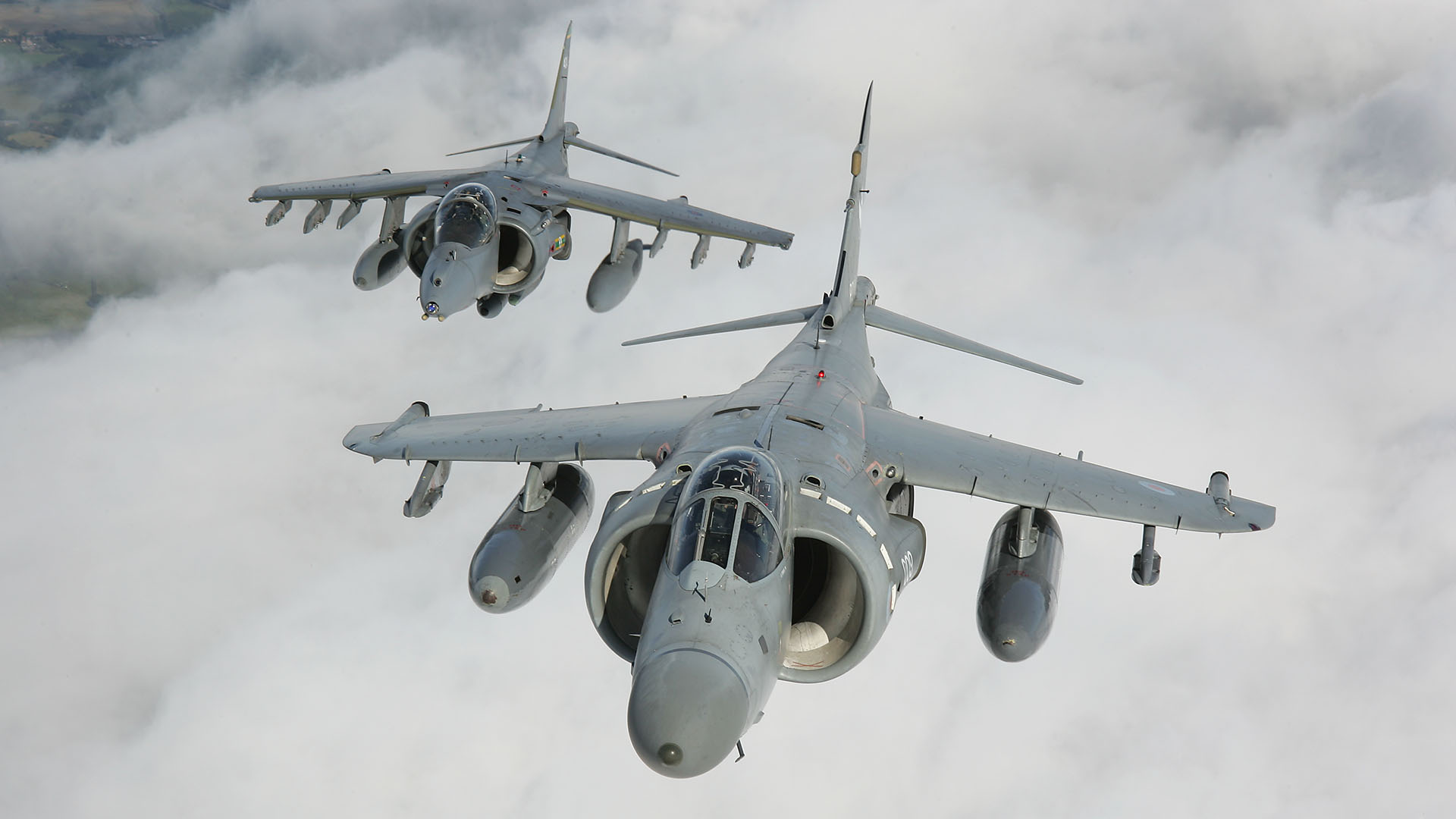
These Harrier IIs represented a generational leap over the original Harrier. The initial British Harrier GR5 variants were swiftly upgraded to the night attack-capable GR7 standard and, eventually, they became GR9s, the ultimate British Harriers. Notably, they lacked an air-to-air radar and were, therefore, less capable in the air defense role than the Sea Harriers.
However, they still boasted a wealth of new equipment including the ability to employ Raytheon Paveway IV precision-guided bomb, the Lockheed Martin Sniper advanced targeting pod, a new Terma defensive countermeasures pod and a helmet-mounted cueing system that it inherited from the Jaguar combat jet.
The first upgraded Harrier GR9 was delivered to No. 1 Squadron at RAF Cottesmore in 2006 as part of a £500-million program – around $920 million in U.S. dollars at the time – that updated the avionics of 60 Harrier GR7/7As to GR9/9A standard, and 11 T10 trainers moving to T12 configuration. The “A” variant featured uprated Pegasus Mk107 engines, which provided precious extra thrust for hot and high operations and improved shipborne performance.

Winds of change
Operation Herrick in Afghanistan was a major focus for the Harrier force from 2004-2009, with elements of JFH having deployed to Kandahar straight after Operation Telic in Iraq in 2003. Initially planned to run for just nine months, Afghanistan evolved into a grueling five-year commitment for a relatively small force of just three front line squadrons. However, as Harrier came out of the Afghan mission, it became an immediate target for cost savings as the SDSR loomed. The continuing Afghanistan commitment passed across to the RAF’s Tornado GR4s, while the operational Harrier squadrons were all back in the United Kingdom, with the aim of regaining a robust all-around capability that had atrophied after half a decade of close air support in a warzone.
The then Group Captain Gary Waterfall had flown Harriers in the RAF since 1988 and he ultimately notched-up 2,300 hours in the type, ranging from the Harrier GR3, to the GR9A. When he assumed the role of officer commanding JFH in September 2009, he had a clear vision of moving away from a focused close air support-based mission set in Afghanistan to resuming the Harrier’s full range of capabilities, from land and sea.
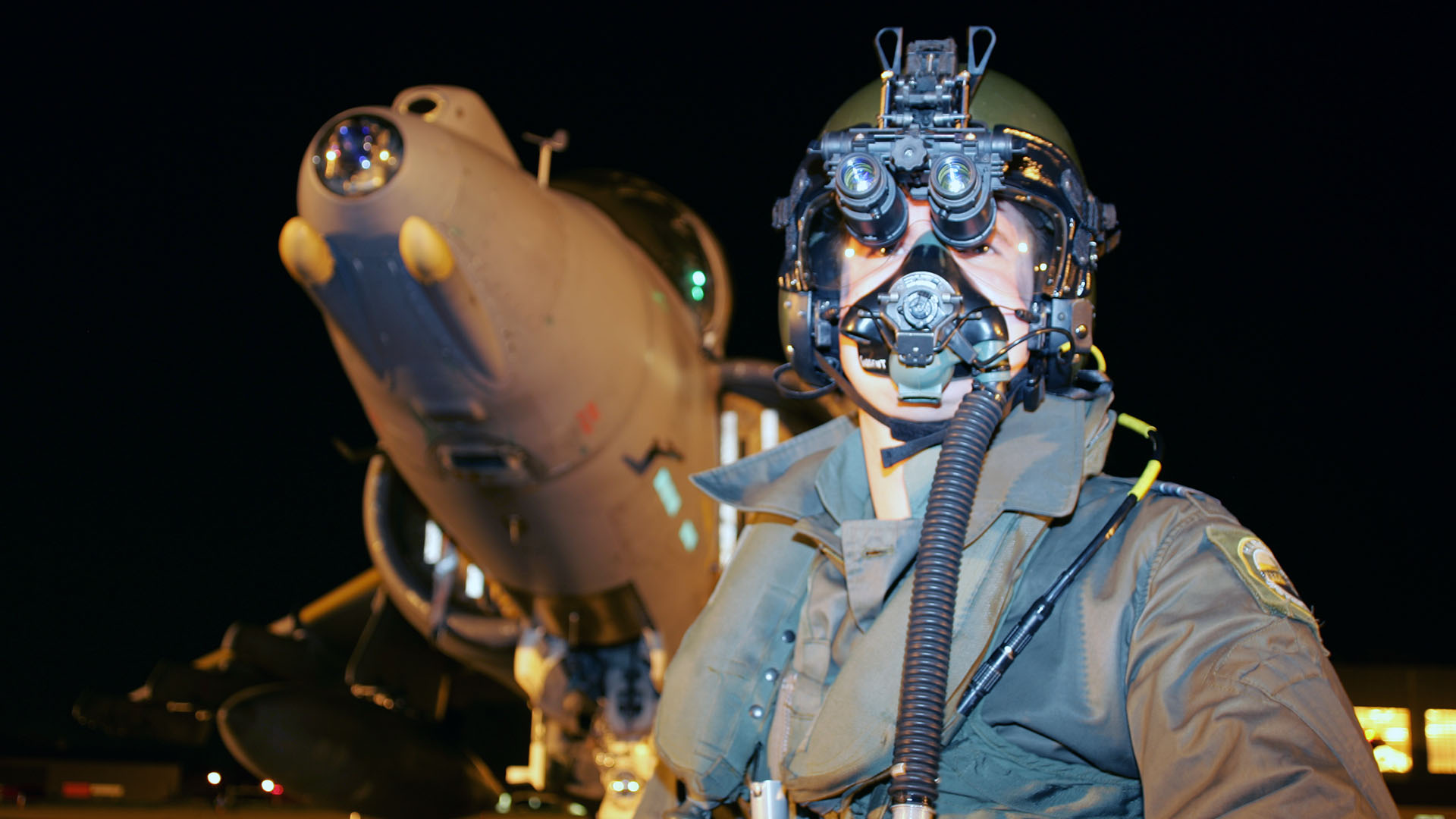
“We’d quite rightly not done a lot of recent work at sea because of the constant deployments to Afghanistan, but we had done some,” Waterfall said. The Harrier GR9 offered the versatility of being able to operate from short land strips, as well as embarking the Royal Navy’s small-deck aircraft carriers to spearhead the UK’s continued carrier strike capability. However, in the background, thoughts were already turning to the forthcoming SDSR.
“From that September through until Christmas there was a lot of work being done on possible savings and talk of the fact that we might have to look at cutting whole capabilities,” Waterfall recalled. “Literally a couple of days before we broke-up for Christmas, the Secretary of State announced that No. 4 (Army-Cooperation) Squadron would close and that the Harrier force would relocate from Cottesmore to nearby Wittering. I think that pretty much cast the die for the eventual culling of the Harrier force.”
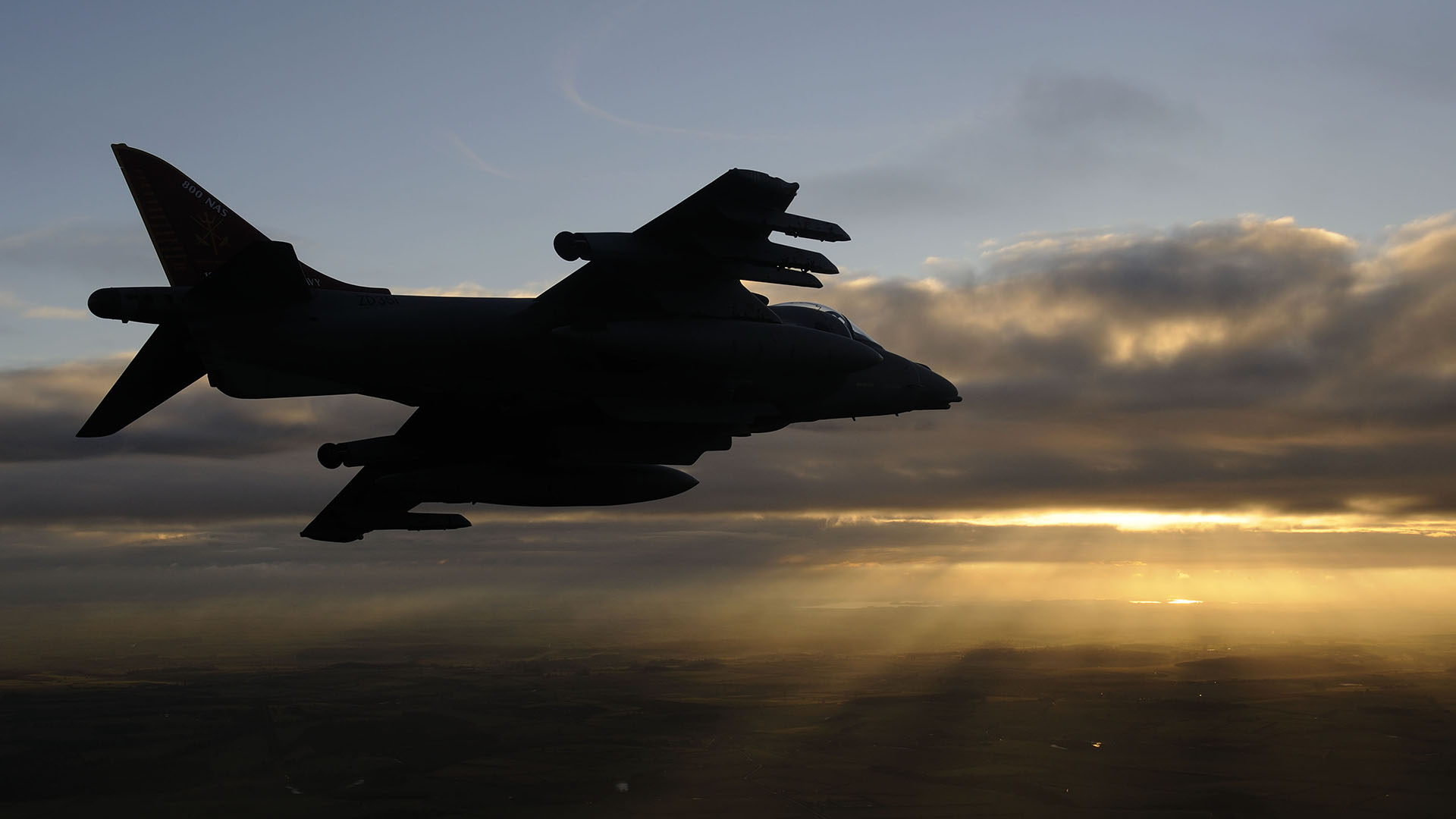
The December 2009 statement from the then-U.K. Secretary of State for Defence Bob Ainsworth said the Harriers would be cut by one operational squadron, with Cottesmore being closed. The remaining two front line squadrons would move to the Harrier’s ancestral home at Wittering by 2011 to join the Harrier Operational Conversion Unit (OCU) as the force was rationalized and centralized. It was a move that never became a reality.
When Waterfall assumed control of JFH it consisted of the RAF’s Nos. 1 and 4 Squadrons, plus a further unit known as the Naval Strike Wing, essentially an amalgamation of 800 and 801 NAS. When No. 4 Squadron was closed down as an operational unit, the number plate was retained by transferring it to the OCU. Waterfall says the cutting of the third front line unit was significant. “It took us from three to two operationally-deployable squadrons,” he explained. This was viewed as a critical reduction in mass, which had real implications regarding JFH’s ability to offer a meaningful capability to the overall combat air picture.
Throughout the summer of 2010 rumours regarding what might be included in the SDSR were rife. The debate raged in the press and both the Tornado and Harrier communities were feeling the pressure of what might come in the SDSR. The bigger swing-wing Tornado GR4 had taken on the Afghanistan mission, and with a force of five front line squadrons it presented a far bigger target for cuts, depending on the level of savings that were required. Five squadrons of operationally-deployable Tornados, versus two of Harriers. Accepting the need for a significant cut in the defense budget, one of these forces would have to go.

Significantly, the new Eurofighter Typhoon FGR4s in RAF service still lacked meaningful ground attack capability. If the Tornado had been cut, that would have been far more significant, as it would have represented a loss of five “offensive support,” or ground attack squadrons.
Moreover, Tornados boasted a wider variety of effects over the Harrier, such as the Storm Shadow cruise missile, which afforded an important strategic capability. If the RAF was to maintain an ambition for scaled warfighting, it was fairly obvious that it would be the Harriers that would go, if it made that binary cut to get rid of an entire force.
A bitter blow
What the Harrier bought the United Kingdom was the flexibility of being able to operate from land and sea. The question was at what price? “I think that’s why the debate raged for so long,” Waterfall said. The decision-making over what would go in the SDSR led to an increasingly fractious relationship between the RAF and the Royal Navy at senior levels. The Navy wanted to sustain a fixed-wing carrier strike capability for the follow-on Queen Elizabeth class aircraft carriers and the F-35, rather than culling the Harrier and taking a “capability holiday.” “I have eternal respect to all within JFH who shouldered the pressure and continued to discharge their duties professionally and in a truly joint sense,” Waterfall added.

While JFH tried to continue business as usual, in the background, a battle raged as to what would survive the Treasury’s axe. “I was in the RAF Club in London about a week before the review was due to be announced, and a senior Royal Navy officer sidled up to me and said: ‘Don’t worry Gary it’s all fine, the deal’s back on the table and the Harrier force looks like being saved,'” Waterfall remembered. “That really showed how close the wire it was in terms of the lobbying that was going on.”
The SDSR was due to be announced on Tuesday, Oct. 19, 2010. The day prior, Waterfall and other senior commanders were asked to assemble at RAF High Wycombe so that the Chief of the Air Staff, Air Chief Marshal Sir Stephen Dalton, could brief them on what the review looked like. It was a somber meeting for Waterfall as the RAF’s most senior officer told them that it was the end of not just the Harrier, but also the entire Nimrod MR2 maritime patrol fleet and the replacement MRA4 version that was in development.
“I drove back to Cottesmore and arrived late, but just in time to greet Wing Commander David Haines who was Officer Commanding No. 1 Squadron, as he completed his 2,500th hour in the Harrier as he came off a night flying sortie. I met him on the flightline, he climbed down, I shook him by the hand and gave him his patch, not knowing whether that was his last hour flying the aeroplane,” Waterfall said. “Everyone knew where I’d been that day. He said: ‘Thanks very much boss, so, what’s happening?’ I couldn’t say a word. I wasn’t allowed to say anything until after it was announced in parliament at 3:30 PM the following day.”

“I’ll never forget, I got home and the news at 10:00 PM came on the TV. It basically started leaking the fact that the Royal Navy aircraft carrier HMS Ark Royal was going to be withdrawn,” Waterfall continued. SDSR also said either HMS Ocean or HMS Illustrious would be decommissioned following a short study to determine which offered the most effective “helicopter platform.” Without the carriers, it made the Harrier’s case look very weak indeed. The next morning, Secretary of State for Defense Liam Fox was interviewed on breakfast TV and he essentially broke the news about the carrier strike “capability holiday” until the introduction of the F-35.
Concerned about how this would affect the Harrier personnel, Waterfall canceled all flying that was planned for the day and insisted that JFH should be told of the news by a senior officer before the official announcement in Parliament that afternoon. Air Vice-Marshal Greg Bagwell, Air Officer Commanding No.1 Group, headed to Cottesmore by helicopter and landed in front of the officer’s mess, away from growing media outside the airfield. “We assembled and Greg Bagwell said ‘I’ve been cleared to tell you in advance the Harrier force will close with immediate effect,’” Waterfall recalls.
Ironically, the government’s decision to retire the Harrier prematurely was announced almost 50 years to the day that test pilot Bill Bedford hovered the Hawker P1127 Harrier prototype for the very first time at Dunsfold, in Surrey, on Oct. 21, 1960.
“I wrote a letter and printed copies to be given to everyone as they left work that evening,” Waterfall said. “It explained that I didn’t know what was going to happen next. From an air force perspective, why carry on flying? Why take any more risk? I told everyone that we wouldn’t fly for at least a week and that they should all get themselves sorted out and ready for the future, whatever that may hold. Feelings and emotions were running high. I got all the Harrier OCU students together and told them that none of them would fly the Harrier again. There was simply no cost-benefit to it.”
“It was one of the hardest things I’ve ever done — cutting them off in their prime.”
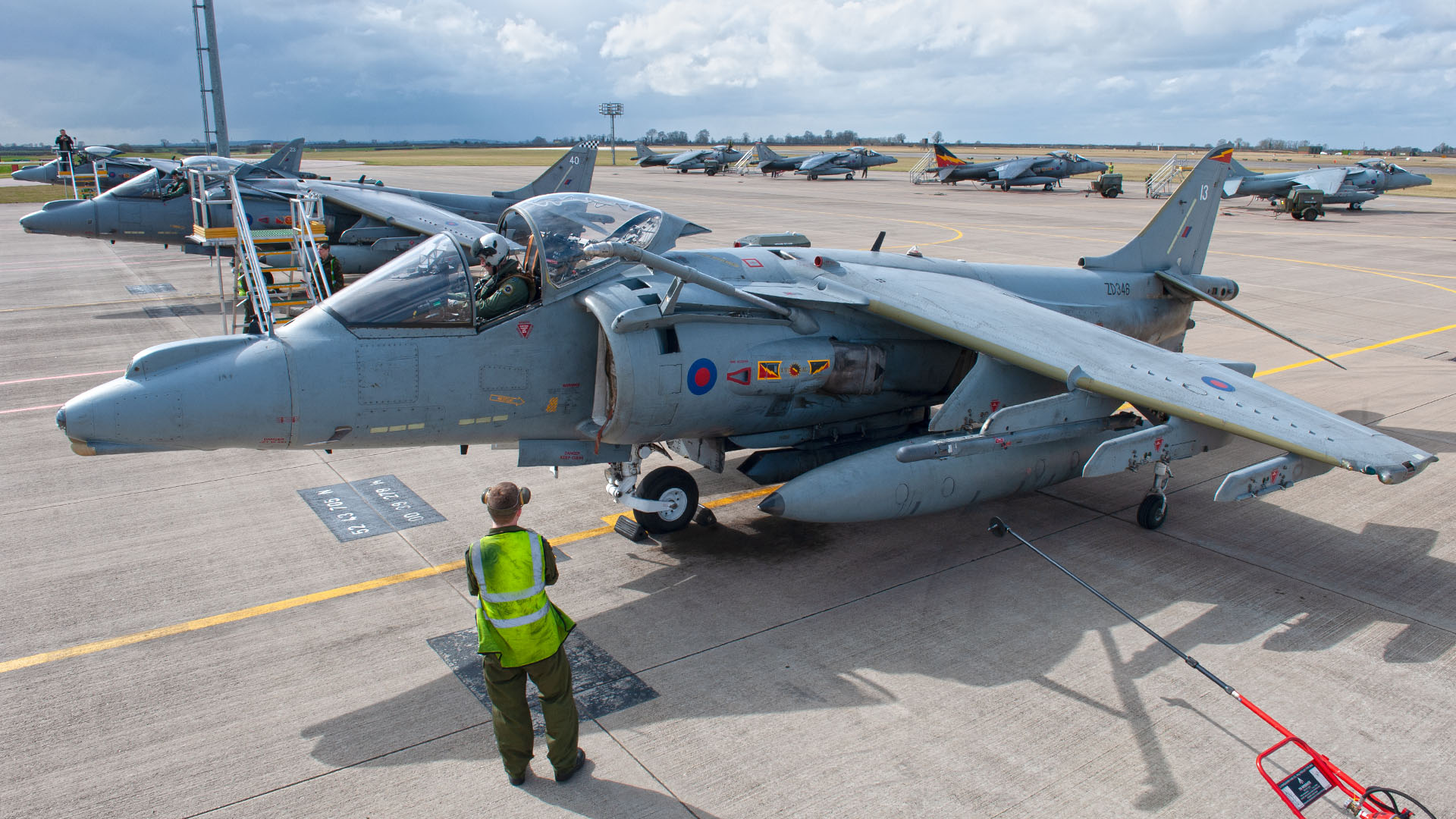
Planning the final act
Desperate to make the force proud and give the Harrier a good send-off, Waterfall and his team started to devise a plan for how the squadrons could continue to safely fly. “Why? Because we were in charge of a nation’s icon,” he explained. “It was important to me we laid her to rest with respect and dignity. But that couldn’t be done overnight.”
After a week of tense negotiations with senior officers, Waterfall was told that the Harrier force could continue flying.
The Harriers had to cease operations by the end of 2010, so Waterfall targeted pre-Christmas for a final farewell event at Cottesmore and the final flights. It gave the force just under two-months to wind down operations, decommission the aircraft, and prepare the assigned personnel for the future.
“I told the squadrons to pick up as many air-land integration slots as possible in order to relieve the burden on Tornado force, so we were directly contributing to defense output. For all of the pilots, engineers, air traffickers, it was about getting them as many qualifications as possible before we stopped flying. I told the two junior pilots on No. 1 Squadron to get themselves combat-ready, because that way they’d only require a quick conversion course in order to move to the Tornado. Had they not been combat-ready they would have been required to undertake an entire OCU. It’s not so much about flying the aircraft, it’s more about learning the role of ground attack.”
Waterfall mandated “measured flying,” with no night flying, and certainly no risk-taking. The Royal Navy wanted to take some jets back to sea for one final embarkation. This was agreed, but Waterfall insisted the embarkation had to be jointly executed between the Air Force and the Navy.
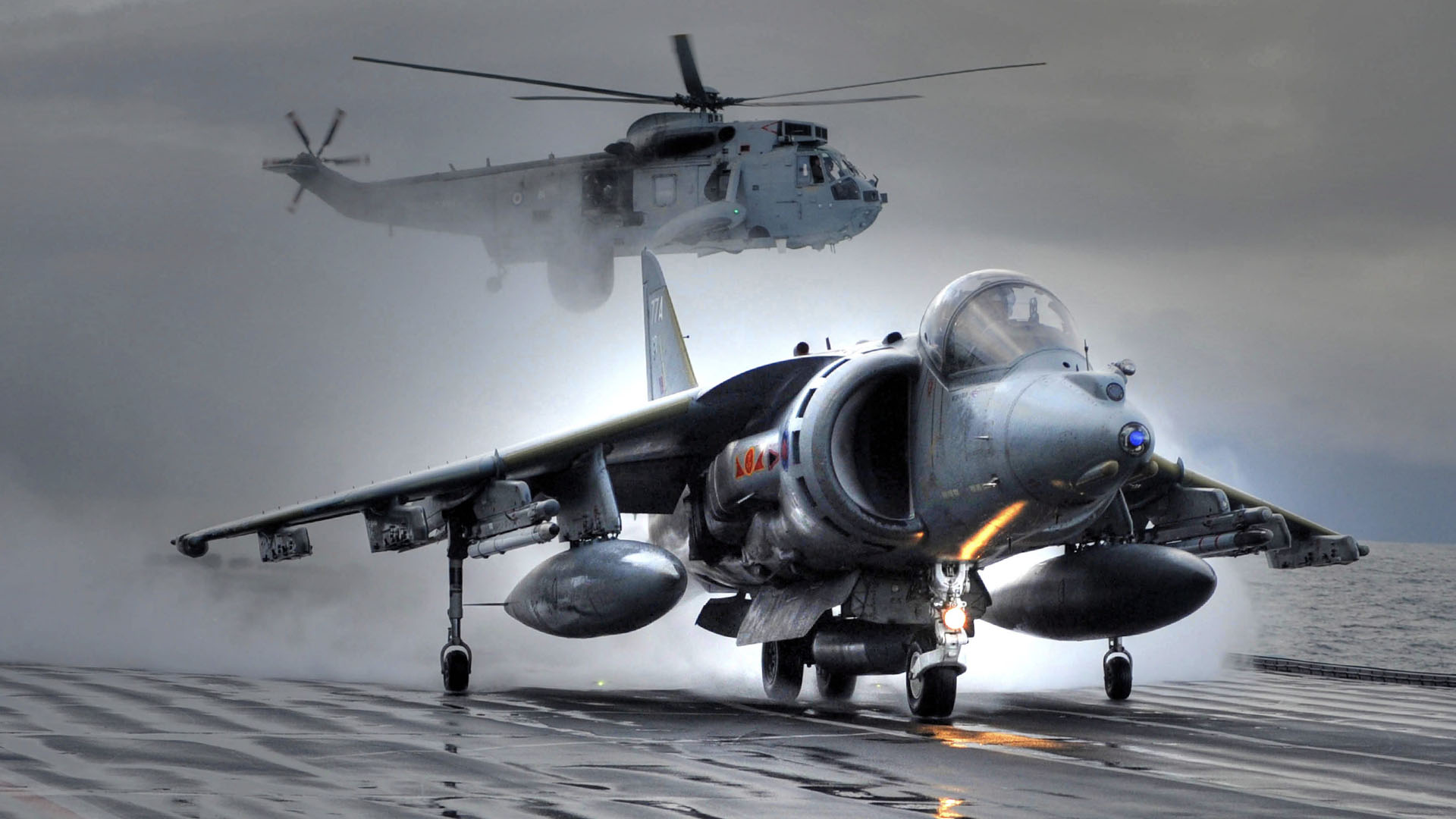
Off the coast of Newcastle in northeast England at 11:55 AM on Nov. 19, 2010, a Harrier GR9 landed on the flight deck of HMS Ark Royal for the last time as Captain Jerry Kyd looked on. When one of the jets arrived with a “for sale” sign in the windscreen it caused serious concern at the highest levels in the services. Indeed, the whole retirement event was placed in jeopardy amid RAF concerns that emotions were running too high.
On the afternoon of Nov. 24, the four Harriers launched from the ship as she cruised the North Sea. The last pilot to take off was Lieutenant Commander James Blackmore, Officer Commanding ‘A’ Flight, No 1(F) Squadron. Like many of his Harrier colleagues, Blackmore went on to an exchange posting with the U.S. Navy to fly F/A-18E/F Super Hornets in order to retain that “corporate knowledge” of fixed-wing carrier operations, which would ultimately support the United Kingdom’s regeneration of carrier strike with HMS Queen Elizabeth and the F-35B.
The final day
Bitterly cold winter weather with ice and snow hit the United Kingdom in early December 2010, bringing havoc to the plans for the Harrier’s final retirement. Because Cottesmore had been earmarked for closure, it lacked any equipment to clear the foot of snow that blanketed its main runway.
Plans for an impressive 16-ship formation of Harriers as the finale on Dec. 15 had been devised by Waterfall, along with detailed planning by Squadron Leader Dunc Mason. Luckily, nearby Wittering avoided the heavy snow and remained open, allowing the remaining pilots to fly the work-up sorties needed for the flypast.
The Harrier OCU was due to leave Wittering en masse on Dec. 9 to centralize the fleet, but Cottesmore remained closed. Luckily, the conditions improved just enough to allow the eight Harriers still at Wittering to depart the following day.
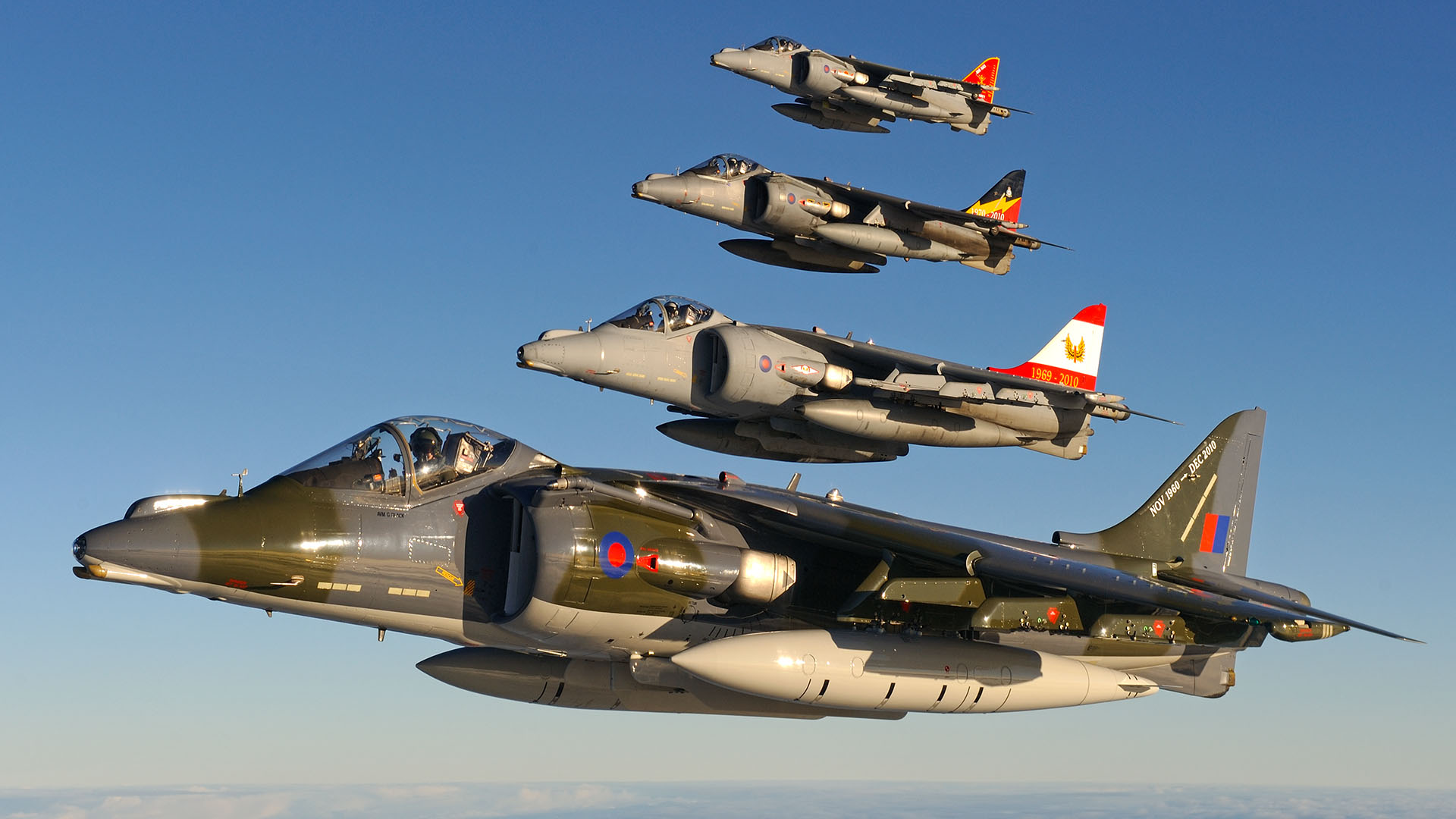
With Dec. 15 looming large, a 16-ship dress rehearsal mission was planned for two days before. But the weather again ruined careful plotting. Low cloud and fog meant the practice was scrapped. It was just too risky to launch 16 jets together. Instead, a sign of improving conditions allowed four specially-painted Harriers to get airborne for a final photocall above the clouds. As they returned to Cottesmore, the clouds parted and bathed the Harriers in golden light as they each touched down.
The dress rehearsal was pushed to Tuesday and the weather was just about acceptable. With time running out, Waterfall gave the signal to launch. The 16 Harriers plus a safety/photo chase got airborne. “We grouped together above the cloud layer over RAF Marham, then dropped beneath the overcast and flew around Wyton, Wittering, Scampton, and Coningsby, but we just couldn’t get the 16 jets into Cottesmore for a flypast,” Waterfall remembered.
As Dec. 15 dawned, the weather was again awful. Hordes of families and media assembled for the Harrier farewell under leaden skies, but notably, the top brass was absent. It was a huge day for Waterfall. He had orchestrated the send-off, including him leading the big flypast as the centerpiece, using the radio callsign “Kestrel formation”. “Big crosswinds across any sort of V/STOL flying is not ideal, especially if you have wind behind you,” he explained. “We got airborne and all joined up above the cloud in the 16-ship diamond.
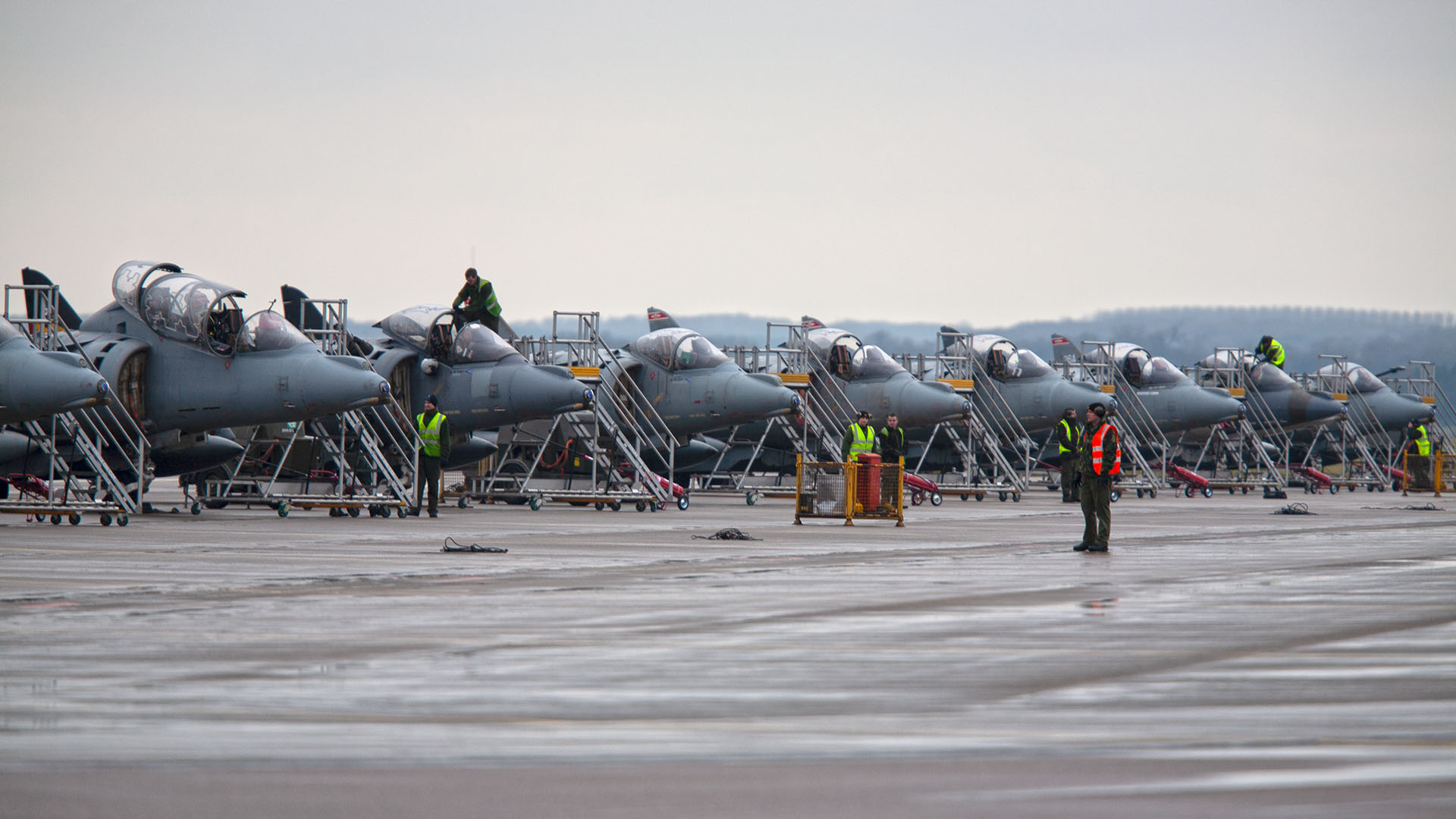
“This was it, the last event. We flew a racetrack up at about 10,000 feet and waited to hear from our weather-ship. He reported ‘a couple of gaps,’ which was enough to tantalize me, but after a few moments of careful consideration I decided it just wasn’t going to be possible to fly the 16-ship over the crowds,” Waterfall said. “We split into four 4-ships and flew back for our carefully orchestrated recovery, which we had briefed in huge detail. Air traffic control did a magnificent job. 16 Harriers broke into the circuit one after another — the sky was full of Pegasus jet noise.”
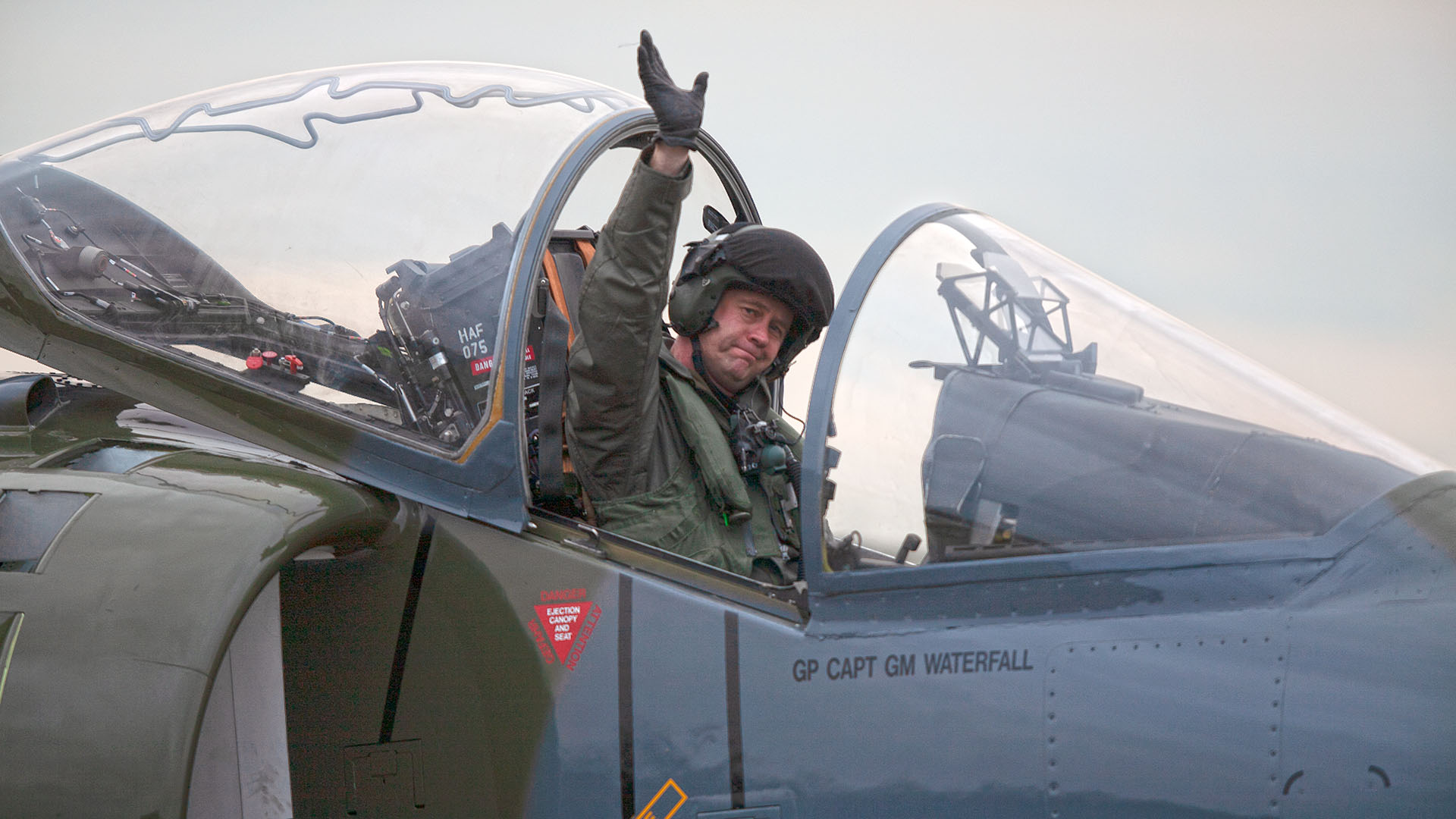
Waterfall was the last jet to enter the hover over the runway, flying a specially-painted retro Harrier GR9A. With a 15 knot tailwind, he executed a traditional Harrier bow to the crowds as they waved flags and cheered. “I came out of the bow, and up came the gear. I turned and made a steep climb away, but had to bunt over at 700 feet to avoid going back into the cloud. Then we landed and all shut down our Pegasus engines in unison at 2:41 PM. We all walked away and didn’t look back. That was the end of it.”
“It was a sad day, but the future was bright with the Queen Elizabeth class aircraft carriers and the F-35. We had to get on the bus of change, there was no point in fighting the decision.”

The day after the final flights, the Daily Telegraph ran a piece about how the Royal Navy wanted to keep 20 Harriers to retain carrier strike skills until 2020, but the plan didn’t get anywhere. The first production British Harrier II serial ZD318 was preserved at Wittering and a couple of other jets were retained for museums. However, 72 Harriers were sold to the U.S. Marine Corps for around $180 million — less than the cost of two F-35Bs—to be used as spares sources for its Harrier force. The hulks still reside in the boneyard at Davis-Monthan Air Force Base in Arizona.
Having led that final 16-aircraft formation, Gary Waterfall offered his comments on the occasion to the gathered media. “Today has been full of emotion, but actually we have a real sense of pride. I love this aircraft and I’ve flown it since I was 21 years old. Aviation closed a chapter today with the demise of the Harrier force. But we have opened a new chapter and we are already looking ahead to the new Joint Strike Fighter. Today was all about retiring the Harrier with the dignity she deserves.”
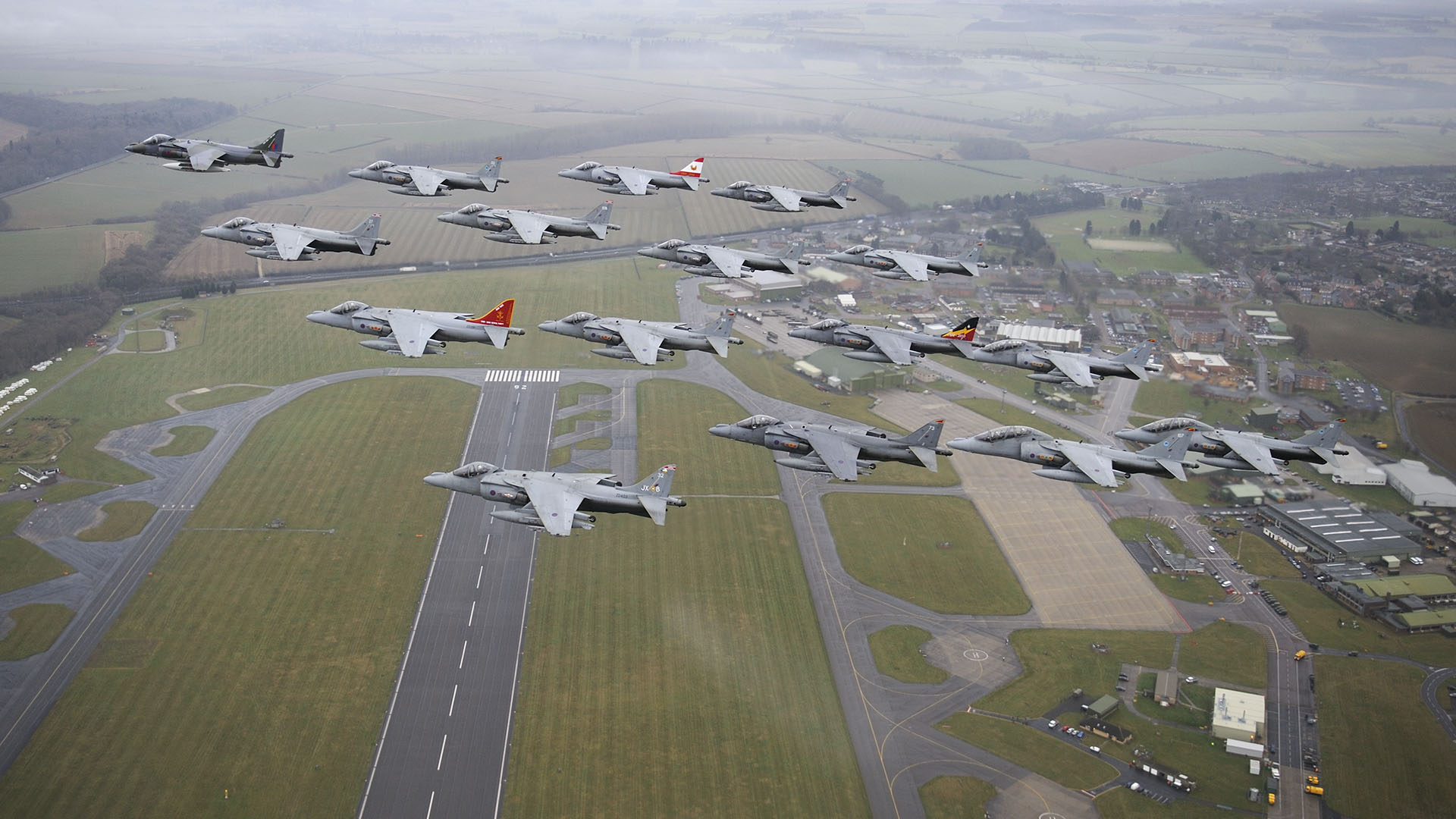
Waterfall went on to become an Air Vice-Marshal and eventually held the prestigious position of Air Officer Commanding No. 1 Group. He commanded the British fast-jet fleet during a period of impressive development in the Eurofighter Typhoon Force, as it became truly multi-role. He also oversaw the introduction of the F-35B, as the new joint RAF/RN Lightning Force was established in the United States in partnership with the Marine Corps.
Despite the pain of retiring the entire Harrier force in just two months, the regeneration of British carrier strike started with that SDSR in 2010. Today it represents a step-change in overall capability. Yet budgets and politics still play a major role.
Later this year, the next comprehensive British defense review will be revealed, now rebranded as the “Integrated Review.” It comes at a time of even worse fiscal challenges due to the COVID-19 pandemic.
Looking back at the SDSR in 2010 serves as a useful reminder of how long it can take to regenerate an expensive and complex organic capability such as carrier strike. Next year, the new British Carrier Strike Group will set sail for its first operational cruise. For the first time in a decade, the joint team will project British carrier-borne airpower globally once again.
When it does, many will remember how the Harrier — a remarkable British-born invention — carved out an important chapter in British history, and gave rise to an aviation era that will never be forgotten.
Contact the author: Jamie@thedrive.com
